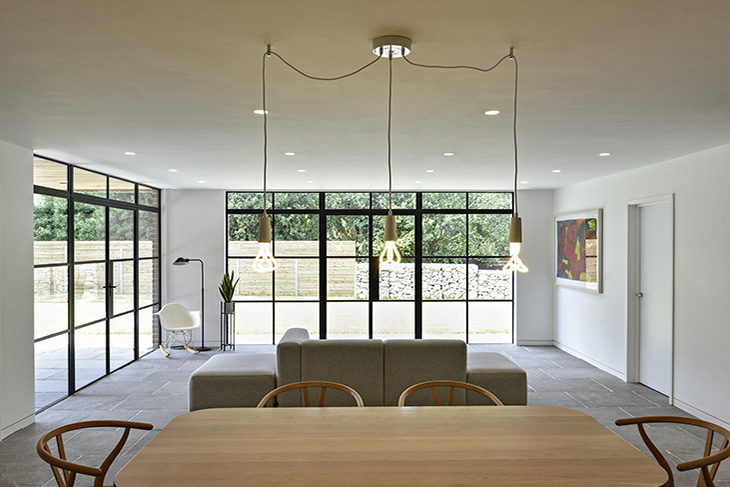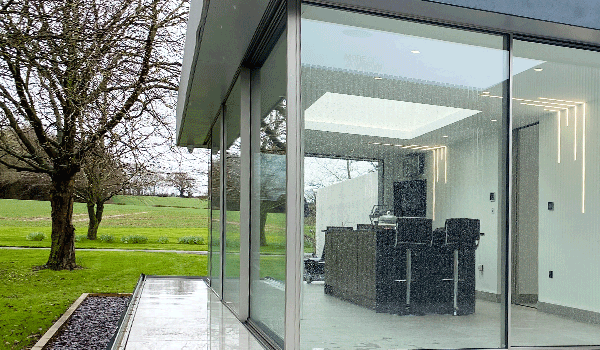March 28, 2021 / By admin
Go back a century, or so, and glass was reserved just for windows to let light into a home – along with draughts and, on very cold days, even a layer of ice on the inside. A revolution began with double glazing. Invented in the USA in the 1930s, this only become widely available in the UK in the 1970’s. But from that point the glazing industry advanced with increasing momentum and today technology has rendered the previously considered impossible, not only possible, but available and affordable.
We can have triple glazing, even quadruple; and we can choose what gas we want the void filled with; argon, xenon or krypton. We can have glass that changes between frosted or clear at the touch of a button. Today’s glazing systems contribute to how to heat a house, instead of the draughty window leaking the heat out. But one of the biggest advances has been in the ability to produce larger and larger pieces of glass safely, facilitating the development of expansive glass walls at a cost that is acceptable for the domestic market.
The current fashion for connecting the inside to the outside via one of the many glazing systems available, looks like it is here to stay, as society increasingly understands the practical, social, psychological and health benefits of outdoor living space. Glazed doors provide this as a visual asset even when the weather does not favour being in the garden. And the ability to remove the walls to the dining room provides a quick and easy way to enjoy the benefits of al fresco eating with the convenience of your usual dining area. A feature particularly useful with the changeable British weather.

French doors have been around for a long time and they still provide a beautiful solution for a smaller doorway to a garden. Their traditional appearance brings a certain charm and elegance particularly in a building where the architectural style of contemporary glazing systems would look out of keeping. However, the small panels and ratio of frame to glass does restrict the view looking out and limit the light coming in.
Crittall doors, also called Belgium Doors, have increased in popularity over the past few years, being a halfway house, with their smaller frame lines and larger panels.
This demonstrates a trend for more light and greater visibility – even the very recent fashion of bi-fold doors is losing its appeal as homeowners demand smaller frames, less panels, larger expanses of glass and level thresholds, all aimed at maximising the area of glazing and minimising any obstruction to the outdoors.
Companies such as IQ Glass, Sightline and Sky-Frame are leading the way with a stunning array of glazing systems for every eventuality. Of course, these systems come with a serious price tag and, whilst such features often form the ‘wow’ factor of a home improvement project, it is important to bear in mind the style, practical requirements and financial limitation of the property value. There is no point in putting a top-end, automatically retracting, enormous, curved glass wall into a two-bed semi with no view and expect the house value to increase enough to cover the cost – it won’t.
However, by the same token it is worth going for the best quality you can afford for a system which is appropriate to the house and location. Glass is heavy and the cheapest systems have a tendency to fail quickly. The panels can distort and drop as the weight of the glass stresses the mechanisms during use.
Once you have done your research and decided what type of glazing system you want, need and can afford, we always recommend visiting the showroom to assess the quality and design of the product before purchase. It is important to operate the system: Does it lock easily? Does it slide or fold easily? Is it heavy? Do you like the style? The feel? The colour? Afterall, this is likely to use a considerable amount of a home improvement budget, so it is important to get it right. If possible, ask the showroom if they have some previous customers you can talk to. If they are happy to put you in contact with previous customers this not only gives an opportunity to speak to someone about the performance of the product in everyday use, but also, gives an indication of the suppliers own confidence in the product.
Of course, architects specify many of these systems in a wide range of situations and are familiar with the pros and cons of the options. If you are in the process of choosing a system we would recommend talking to your architects about which one they would recommend.
With thanks to Sightline Aluminium Glazing Systems for their demonstration during our recent visit.
